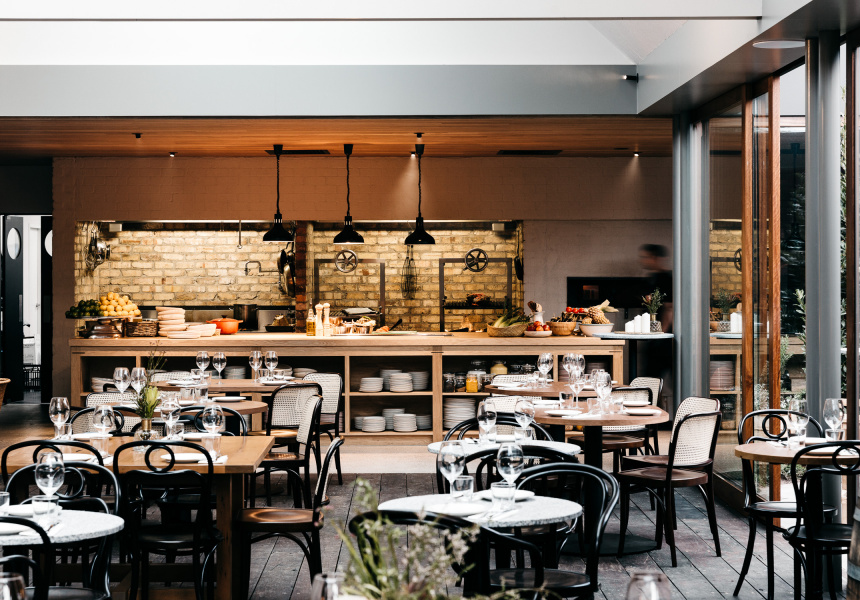These Are the Government Guidelines for Victorian Restaurants and Cafes to Reopen
No tables bigger than six. No self-service cutlery and glass stations, or communal drink and condiment stations. And alcohol can only be served with a meal, “which is more than a snack”. Here’s how you’ll experience dining in Victoria from June 1.
by Katya Wachtel
Victoria’s restaurants and cafes will be allowed to reopen for dine-in customers on June 1 after two months in mandatory shutdown. Restaurants inside pubs, bars, RSLs and other licensed venues will also be allowed to reopen.
The Victorian government released its “Hospitality Industry Guidelines for coronavirus” – a 30-page document outlining rules and recommendations for venues to adopt in reopening – on Monday evening.
The document “is intended to assist hospitality businesses to prepare to safely resume operations in accordance with the easing of restrictions, while also ensuring the public feels confident that their health and safety is being protected”, it says.
Venues will be allowed 20 customers per separate dining space – not including staff – with a “density quotient of one patron per four square metres of floor space accessible to patrons”.
That means a two-storey restaurant could have up to 40 customers at once, with 20 on the ground floor and 20 up top. The same rule applies to a restaurant with both outdoor and indoor dining areas. Private dining rooms will also be treated as discrete spaces. The catch? “To seat 20 patrons the dining floor area accessible to patrons must be a minimum of 80 square metres. If the dining floor area is smaller than 80 square metres, the density quotient applies.”
Tables can have no more than six diners each, and must be arranged so that customers aren’t closer than 1.5 metres when seated.
Communal self-service stations are off the table; signs clearly stating the maximum number of patrons allowed at one time must be placed at entrances; floor markings or physical barriers must be used at cashiers.
As for fears that restaurants would be forced to use disposable cutlery, the government has said venues are allowed to use their standard cutlery, crockery and beverage containers “with appropriate hygiene, cleaning and sanitation processes in place”.
Venues can have shared plates on the menu, but there's no buffet service allowed.
“Alcohol can only be served with a meal, which is more than a ‘snack’,” the document says. “Restaurants and cafes should use common sense in applying this requirement noting that menus are all different. That said, alcohol must not be served without food or with snack food only.”
Victoria Police can issue on-the-spot fines of up to $1652 for individuals and up to $9913 for businesses for refusing or failing to comply with the government's directions. (Larger fines of up to $20,000 for individuals and $100,0000 for businesses are possible through the courts.)
What venues must do
• Have provisions in place to record patrons’ contact details on booking or entry, with name and a contact number (the details of every patron should be recorded, not just one per table).
• Undertake a deep clean of the premises and implement additional hygiene and cleaning measures and practices.
• Display a sign at each public entry that includes information on the maximum number of people that can be present in the space at a single time, rounded down to the nearest whole number.
• Display posters on good hygiene and handwashing practices in prominent places and establish hygiene stations (with hand sanitiser) at entrances and throughout the venue to encourage hand hygiene among staff and patrons.
• Maximise ventilation where possible.
• Provide physical barriers or floor markings to ensure physical distancing is maintained at cashiers, or consider installation of sneeze guards.
• Limit dine-in service to table service only (i.e. no communal self-serve stations).
• Allow only six diners per table, with tables arranged so that customers aren’t closer than 1.5 metres when seated.
• Reduce touch points where possible, for instance by using contactless payments, laminated menus that can be cleaned in between each use, minimising condiments on tables and removing communal and self-service equipment.
• Remove, or prevent access to, any self-service or buffet-style food service areas and communal condiment and drink stations. Drinking water should be supplied free via table service.
• Menus should be either laminated and sanitised after each use or single-use paper menus. General non-contact signage can also be used to display your menus. Takeaway menus should be placed outside the venue.
• Children’s play areas must remain closed.
Recommendations
• Encourage online and phone bookings, and limit the number of walk-in diners.
• Mark queueing spots to ensure a 1.5-metre spacing between each person in a queue.
• If practical, arrange seating so different groups of customers are not seated face-to-face.
• Encourage customers to remain at least 1.5 metres apart when moving through the business.
• If possible, stagger seating times and manage the duration of sittings to control the flow of patrons.
• Encourage customers to use contactless payment methods such as credit or debit cards, and phone or other payment-enabled devices instead of cash.
• Consider using physical barriers, such as plexiglass screens, at counters where interactions with customers frequently occur.
• If practicable, set up separate venue entry and exit points.
• Have set seatings so there is minimal overlap between different groups. If businesses choose to impose a time limit on bookings, this should be kept to less than two hours, particularly if there is more than one group sharing the same space.
• Limit queues for toilets and have adequately spaced markers on the floor to promote physical distancing. Advise patrons to return to their seats if physical distancing cannot be practiced while queueing.
You can find the full guidelines here.